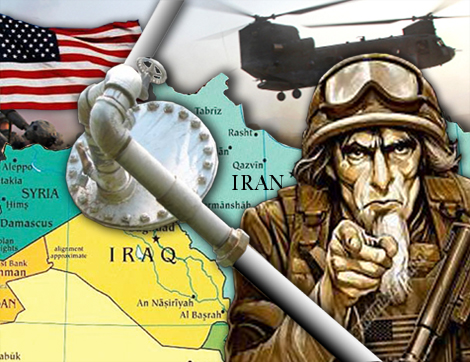
• Seems like everywhere an oil or gas pipeline pops up, U.S. troops are soon to follow
By Pete Papaherakles
As tensions rise in the Middle East amid threats of war in Syria and Iran, Americans are told both these countries are in need of “regime change.” Human rights and democracy are the reasons cited for intervention in Syria, while nuclear weapons and the sponsoring of terrorism are Iran’s alleged crimes. Could the real reason be an abundance of natural resources located in and around them?
In July 2001, as the media and the North Atlantic Treaty Organization (NATO) launched their campaign to demonize Syria’s Bashir al-Assad, the government of Syria, Iran and Iraq signed a historic gas pipeline energy agreement, which was ignored by the Western press. This pipeline would take three years and $10B to complete and would run from Iran’s Port Assalouyeh in the Persian Gulf to Damascus via Iraq. Iran plans to further extend the pipeline from Damascus to a port in Lebanon for delivery to European Union (EU) markets.
The source of this natural gas is the South Pars gas field in the Persian Gulf, the world’s largest single gas field. Both Shiite Iran and Sunni Qatar on the opposite side of the gulf share claim to this vast gas field. Iran, Iraq and Lebanon are Shiite countries, and Assad’s Alawite Muslims are Shiite friendly. The Shiite-Sunni dialectic is used extensively in geopolitical propaganda by the West in its divide-and-conquer strategy for Mideast control.
The United States has been heavily arming Qatar, a tiny country smaller than the U.S. state of Connecticut, with less than 2M people. Qatar is the Pentagon’s control hub for U.S. Central Command, headquarters for the U.S. Air Force Central Command as well as Britain’s Royal Air Force and the heart of NATO’s military presence in the gulf. Qatar and its sponsors have no interest in the pipeline’s success and have their own plans on how to bring Qatar’s share of this gigantic gas field to EU markets. Qatar, a major buyer of U.S. military equipment, has been a leading weapons supplier to the Syrian “rebels” in the attempt to destabilize Syria.
In August 2011, another gas field was discovered, in Qara, Syria, near the border with Lebanon and near the Russian-leased naval port city of Tartus. Although the Russians have been trying to play down the importance of this base, it is of huge significance, for it is Russia’s only base in the Mediterranean. Tartus will also be the port of destination for the gas pipeline. Through Russian energy giants Gazprom and Rosneft, Iranian and Syrian gas will go to EU markets, further enhancing Russia’s leading role as Europe’s gas and oil supplier.
To put the natural gas issue in perspective, the U.S. and Russia are by far the largest producers in the world, with about 611 and 589B cubic meters per year respectively, followed by Canada with 152B cubic meters (m3), Iran with 139B m3, and Qatar with 116B m3.
However, when it comes to proven reserves, which determine the future, the picture is quite different. The world’s total known reserves are around 200T m3. Of that, Russia is in the lead with 45T m3, Iran with 30T m3, Qatar with 25T m3, while Saudi Arabia, the U.S. and Turkmenistan have less than 8T m3 each.
Even with less than 8T m3, however, Turkmenistan’s natural gas, which will supply huge populations in India and Pakistan, was a sufficient reason to invade Afghanistan and secure the Turkmenistan-Afghanistan-Pakistan-India pipeline.
In 1999, Iran signed an agreement for the Iran-Pakistan-India gas pipeline (IPI) and was in the process of constructing it. The IPI pipeline would emanate from the same Port Assalouyeh of the massive South Pars gas field, go through Afghanistan and into Pakistan and India. Subsequent attempts by Iran to continue with the project have been thwarted by the U.S. and its proxies. The wars in Afghanistan and Pakistan have been used to effectively keep Iran out of this market, as have brutal Western sanctions, which make it difficult for countries to do business with Iran.
With U.S. military and economic support, Israel is becoming a leading force in the Middle East, and the energy business is the biggest game in town. Israel has recently discovered gas in what it claims as its territorial waters, 85 miles into the Mediterranean. Estimated at about .5T m3, it is a titanic find for Israel. Partnering with Noble Energy of Houston, Texas, Israel is expected to start harvesting gas by the end of 2012. This leviathan gas field is part of a larger vein of gas deposits in the eastern Mediterranean estimated at 15T m3 that extend into the territorial waters of Cyprus, Greece, Syria and Egypt.
Israel and Noble Energy have moved in to partner with Cyprus, and they are looking to do the same with Greece. Unfortunately, with Greece’s sovereignty tempered by European banks, the Greek government’s ability to defend its assets has been significantly curtailed. As a result, Israel is poised to become a major energy player in the area.
For these reasons, it now looks like Syria and Iran have been declared rogue states in need of regime change. Control of energy resources is the true reason why the U.S. has been “fighting terrorism” and “promoting democracy” in the Mideast.
Peter Papaherakles, a U.S. citizen since 1986, was born in Greece. He is AFP’s outreach director. If you would like to see AFP speakers at your rally, contact Pete at 202-544-5977.




